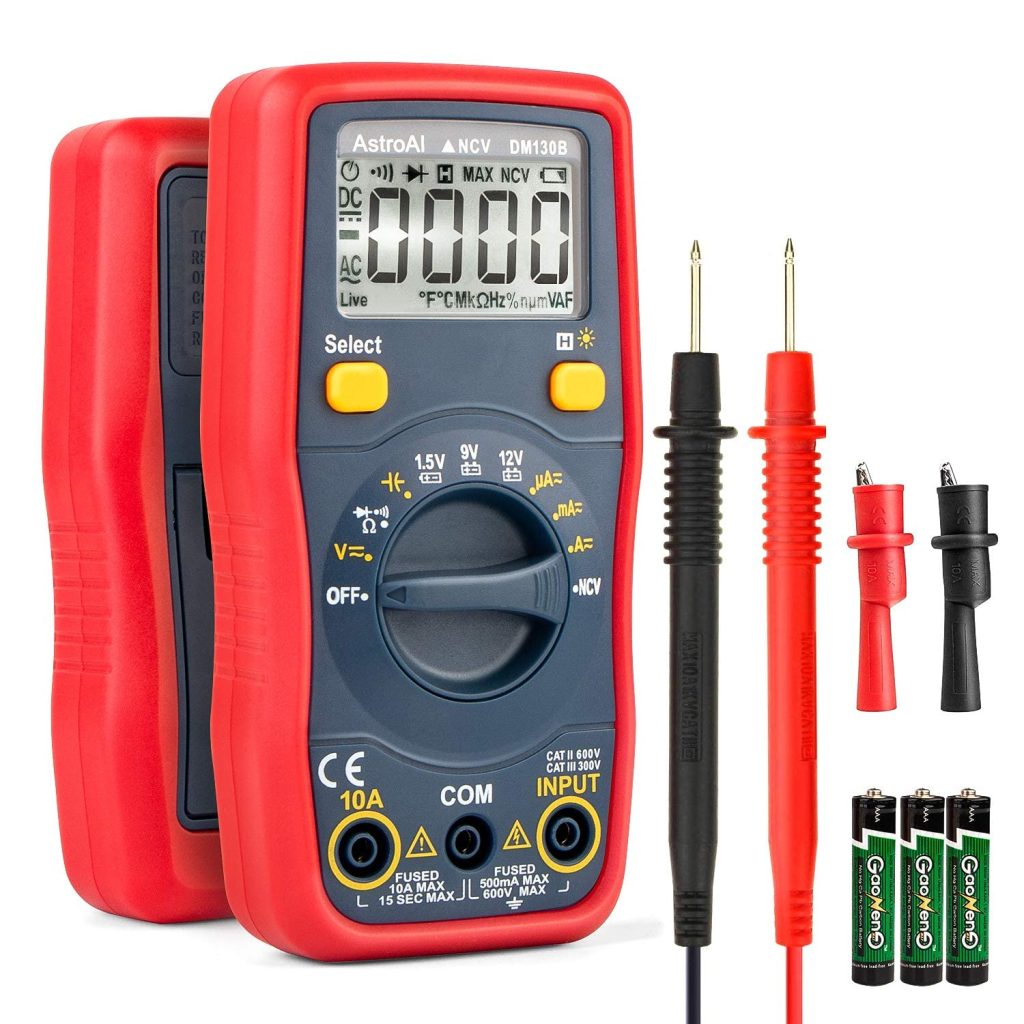Understanding Battery Volt Meters is essential before buying this tool. In an age where portable electronic devices dominate our daily lives, understanding battery health and performance has become increasingly critical. Battery volt meters serve as essential tools in this quest, providing users with accurate readings of voltage levels to assess battery status across a wide range of applications.
A battery volt meter, often simply referred to as a voltmeter, is a precision instrument used to measure the electrical potential difference between two points in an electrical circuit.
From consumer electronics to automotive systems, these instruments not only help in diagnosing battery issues but also play a pivotal role in optimizing the longevity and efficiency of power sources. This comprehensive guide aims to unravel the intricacies of battery volt meters, exploring their functionality, types, and applications.
By delving into the fundamentals of voltage measurement, users can gain insights into selecting the right volt meter for their specific needs, understanding how to interpret readings, and recognizing common pitfalls.
Whether you are a seasoned technician, a hobbyist, or simply a curious consumer, this article will equip you with the knowledge necessary to make informed decisions about battery maintenance and performance.
In the context of batteries, it quantifies the stored energy available, expressed in volts. From tiny watch batteries to massive industrial power sources, volt meters play a crucial role in maintaining system health and performance.
Join us as we navigate the complex yet fascinating world of battery volt meters, providing clarity and expertise to enhance your understanding of these invaluable tools.
Types of Battery Volt Meters
While the core function remains consistent, volt meters come in various forms, each tailored to specific applications:
Digital Multimeters (DMMs)
Versatility: These workhorses measure voltage, current, resistance, and often other parameters.
Precision: Offer high accuracy and resolution, making them suitable for critical applications.
Features: Many models include data logging, auto-ranging, and backlighting.
Analog Multimeters
Classic Design: Rely on a needle and scale for voltage indication.
Durability: Known for their robustness and ability to withstand harsh environments.
Skill-Based: Require more operator skill for accurate readings.
Dedicated Battery Testers
Specialized: Designed specifically for battery testing, often with features like load testing and state-of-health assessment.
Ease of Use: User-friendly interfaces and clear displays.
Battery-Specific: Optimized for particular battery types (e.g., car batteries, lithium-ion batteries).
Clamp-on Meters
Non-Invasive: Measure current without breaking the circuit.
Versatile: Can also measure voltage and resistance.
Industrial Use: Commonly employed in electrical installations and maintenance.
Understand battery volt meters’ essential functions and applications in various industries.
Battery volt meters play a crucial role in monitoring and maintaining the health of battery systems across various industries. These instruments measure the voltage of a battery, providing critical insights into its state of charge and overall performance.
In sectors such as automotive, renewable energy, and telecommunications, accurate voltage readings are essential for ensuring the reliability and efficiency of power systems.
For instance, in electric vehicles, volt meters help assess battery performance and manage energy consumption, while in solar power applications, they enable the monitoring of battery storage systems to optimize energy usage.
Moreover, battery volt meters find applications in industrial settings, where they assist in predictive maintenance and operational efficiency.
By continuously monitoring battery voltages, companies can detect early signs of battery degradation, preventing costly downtime and extending the lifespan of battery assets.
Additionally, these devices are integral in quality control processes, ensuring that battery packs meet specified voltage requirements before deployment.
Ultimately, the ability to accurately measure and analyze battery voltage is essential for enhancing safety, performance, and sustainability across various technological landscapes.
Key Factors to Consider When Choosing a Volt Meter
Learn how to select the right volt meter for your specific battery type and needs.
Selecting the appropriate volt meter for a specific battery type and application requires a careful consideration of several key factors.
Firstly, it is essential to understand the voltage range of the battery in question, as volt meters come in various specifications tailored to different voltage levels. For instance, a volt meter suitable for a 12V automotive battery will differ from one designed for a 48V solar battery system.
Additionally, the current draw of the battery during operation should also be taken into account, as certain volt meters are equipped to handle specific load conditions and peak currents.
Another vital aspect to consider is the meter’s accuracy and resolution, which can significantly affect the quality of the readings.
Higher precision meters may be necessary for critical applications where even slight voltage variations can impact performance.
Features such as data logging capabilities, display types, and connectivity options should also influence the decision, ensuring that the chosen volt meter not only meets the technical requirements but also aligns with user preferences and operational needs.
By carefully evaluating these factors, users can select a volt meter that effectively supports their battery management goals and enhances overall system reliability.
Accuracy
The degree of precision required for your application.
Range
The maximum voltage the meter can measure.
Resolution
The smallest voltage change the meter can detect.
Features
Additional functions like data logging, backlighting, or auto-ranging.
Durability
The meter’s ability to withstand environmental conditions.
Battery Type
If testing specific battery types, ensure compatibility.
Budget
Determine your spending limit.
Explore common features found in battery volt meters, enhancing usability and accuracy.
Common features in battery volt meters significantly enhance usability and accuracy, making them vital tools for both professionals and enthusiasts alike.
One of the most useful features is the digital display, which often provides clear, real-time readings of voltage levels.
Many modern meters also include backlit screens, allowing for easy visibility in low-light conditions. Additional functionalities such as automatic range selection and hold functions enable users to capture and maintain readings without the need for constant monitoring, thereby improving measurement efficiency.
Furthermore, advanced models may incorporate connectivity options, such as Bluetooth or USB, allowing for seamless data transfer to smartphones or computers.
This capability can facilitate detailed analysis and long-term monitoring of battery performance.
Some volt meters also feature built-in alarms or indicators that notify users when voltage levels fall outside of predefined thresholds, enhancing safety and preventing potential damage to the battery.
Together, these features not only boost accuracy but also make battery volt meters more user-friendly, catering to a wide range of applications in various settings.
How to Use a Volt Meter
Safety First: Always prioritize safety. Wear appropriate protective gear and follow safety guidelines.
Select the Right Range: Ensure the meter’s range is suitable for the expected voltage.
Connect Properly: Connect the meter’s probes to the battery terminals, observing polarity (red to positive, black to negative).
Read the Value: The meter will display the voltage.
Interpret Results: Compare the reading to the battery’s rated voltage. A lower voltage indicates a weakening battery.
Common Battery Types and Voltage Levels
Alkaline Batteries: Typically 1.5V per cell.
Lithium Batteries: Can range from 3V to 3.7V per cell.
Lead-Acid Batteries: 2V per cell (commonly 12V or 24V for car batteries).
Nickel-Metal Hydride (NiMH) Batteries: 1.2V per cell.
Discover maintenance tips to prolong the lifespan of your battery volt meters effectively.
To ensure the longevity and reliable performance of battery volt meters, regular maintenance is essential. Periodic cleaning of the device, especially the terminals and connectors, can prevent corrosion and ensure accurate readings.
It’s advisable to use a soft, dry cloth for cleaning and to avoid abrasive materials that could damage sensitive components. Additionally, proper storage is crucial; keeping the meter in a protective case when not in use can shield it from dust, moisture, and physical damage.
Another key aspect of maintenance is battery care. Regularly check and replace the batteries as needed, using only recommended types to prevent leaks that can compromise the internal circuitry. If the volt meter features an auto-off function, enabling it can help conserve battery life.
Ensuring that the device operates within its specified temperature range and avoiding prolonged exposure to extreme conditions will further protect its internal components, ultimately enhancing its performance and durability over time.
Troubleshooting Common Issues
Inaccurate Readings: Check battery connections, probe contact, and meter calibration.
Meter Not Turning On: Verify battery power for the meter itself.
Damaged Probes: Inspect for wear or breaks.
Maintaining Your Volt Meter
Calibration: Regular calibration ensures accuracy.
Storage: Store in a cool, dry place away from magnetic fields.
Battery Care: Replace meter batteries when necessary to avoid unexpected shutdowns.
Gain insights into interpreting volt meter readings for optimal battery management and performance.
Interpreting volt meter readings is crucial for effective battery management and performance optimization.
A volt meter provides real-time data regarding battery voltage, which serves as an indicator of the battery’s state of charge. For instance, a fully charged lead-acid battery typically reads around 12.6 to 12.8 volts, while readings below 12.4 volts suggest that the battery is partially discharged.
Understanding these values allows for timely interventions, such as recharging or replacing batteries before they reach critical states, thereby extending their lifespan and maintaining performance.
Moreover, fluctuations in voltage readings can indicate underlying issues, such as poor connections, sulfation, or the need for maintenance. Consistent monitoring helps identify trends that may signal impending failure or inefficiencies.
By proactively addressing these issues, such as cleaning terminals or ensuring proper charging practices, users can enhance battery reliability and overall system performance.
Incorporating these insights into regular battery management routines not only promotes optimal functionality but also contributes to long-term cost savings and improved safety.
Conclusion
In conclusion, understanding battery volt meters is essential for anyone looking to effectively monitor and manage their battery systems.
This comprehensive guide has highlighted the key features, functionalities, and applications of volt meters, emphasizing their importance in ensuring battery efficiency and longevity.
Whether you’re an amateur enthusiast or a seasoned professional, being equipped with knowledge about voltage measurements enables you to make informed decisions, prevent potential issues, and optimize performance across various devices.
As technology continues to evolve, staying informed about the latest advancements in battery monitoring tools will empower you to harness the full potential of your power sources.
A reliable volt meter is an indispensable tool for anyone working with batteries. By understanding the different types, considering key factors, and following proper usage guidelines, you can select the ideal meter for your needs and ensure accurate battery measurements.



